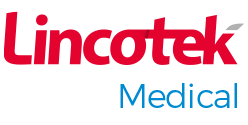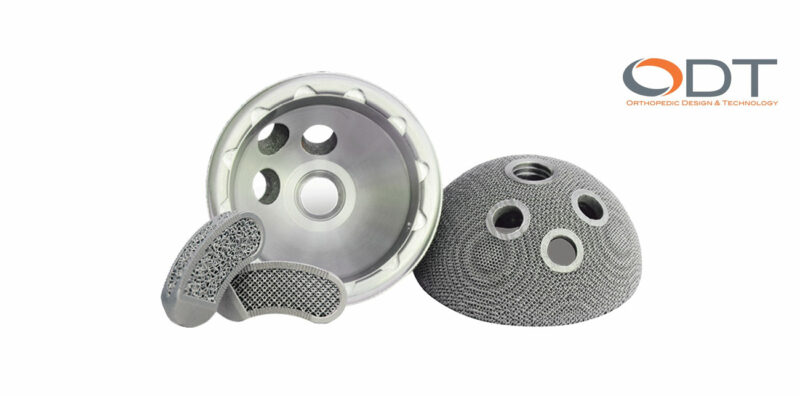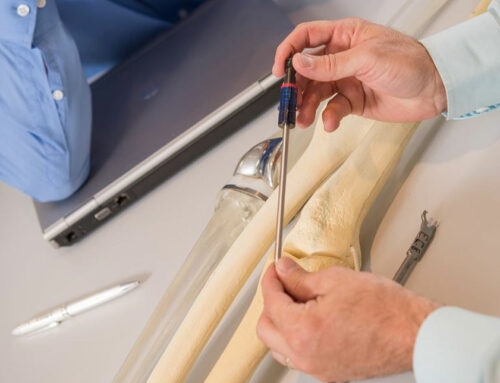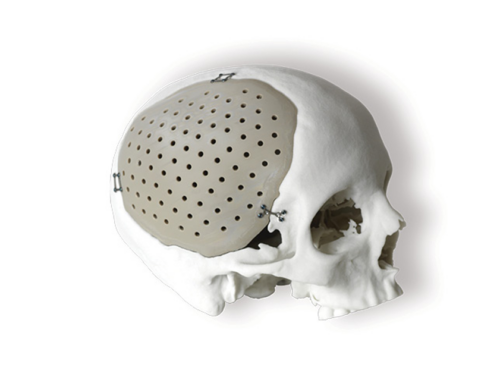Supply partners provide innovative services to orthopedic device makers to help enhance their implant offerings.
Implant manufacturers are not just interested in selling their existing product lines—they are also active in new product development. Much of this R&D is driven by additive manufacturing (AM) opportunities. New coatings and surface treatments are also being developed to aid osseointegration or prevent infections. As implants continue to get smaller, smarter, and more efficient, medical device manufacturers (MDMs) are relying more on their contract manufacturers (CMs) for guidance and support, especially for complex designs that cannot be manufactured using traditional methods. MDMs also want more advice on material selection, manufacturability, and regulatory processes—for example, dealing with the changes to the EU’s Medical Device Regulation (MDR) that are making it more difficult to bring new products and technologies to Europe.
“As a contract manufacturer, these challenges create more opportunities for us to play an expanded role in medical device innovation, which is very exciting,” said Lindsay Mann, director of sales and marketing for MTD Micro Molding, a Charlton, Mass.-based provider of micro medical manufacturing services, ranging from material selection to assembly and packaging.
However, as rich as these opportunities are, they can only go as fast as supply chain constraints—long lead times, labor shortages, and inflationary pressures—will allow them.
“The impacts of these trends have increased cost of goods and inventory levels, putting OEMs in a bind as they face the long-term trend of implant price erosion at the customer level,” said Dave Anderson, co-founder and marketing and business development leader for Mach Medical, a Columbia City, Ind.-based contract manufacturer of joint replacement implants. “High inventory levels have plagued the industry for decades and cost OEMs an estimated 8 percent of revenues every year.”
What OEMs Want
MDMs and their CMs are desperate for shorter lead times and end-to-end solutions that reduce supply chain and logistical burdens as well as deliver products to market quickly. When appropriate, they will invest in technologies that help them to meet cost-effectiveness objectives and shorter delivery times. Orthopedic companies also seek more expert regulatory guidance from their CMs, as well as more documentation to support their technological solutions, including the technical and clinical evidence that is needed to streamline the regulatory approval process.
A key focus for OEMs regarding implant design is “new surface technologies that reduce infection risk, improve material performance, and aid innovation in design—without forgetting how expensive it is to take a new product into the market due to stricter regulatory requirements,” said Enrico Sandrini, strategic business development director for Lincotek Medical, a Trento, Italy-based global contract manufacturer of implants for the orthopedic, trauma, and spine markets.
One way surgical implant developers can reduce costs is to eliminate secondary operations by incorporating more features into their implant designs, which can push the limits of manufacturing and material science. These designs include greater complexity, tighter tolerances, thinner wall stock, sharper radii, and more exotic materials. “In addition to adding more features, OEMs are making designs more universal so the same implant can be used across multiple device applications and product lines,” said Sherry Bekier, account manager for MTD Micro Molding. “The medical device development field is extremely competitive, so it is imperative for products to get to market quickly, with the highest quality and best functionality possible.”
Additive manufacturing represents a suite of technologies that are in high demand for orthopedic implants. To maximize their contribution to the healthcare ecosystem, especially toward developing effective point-of-care manufacturing in hospital settings, it is critical AM equipment manufacturers establish and maintain partnerships with regulatory agencies, build a comprehensive understanding of the key factors driving clearance of devices, and understand common pitfalls to avoid. Well-structured quality assurance programs and protocols are also essential for regulatory acceptance.
“Our role is not simply to help navigate the regulatory process,” said Gautam Gupta, vice president and general manager for medical devices for 3D Systems, a Rock Hill, S.C.-based provider of 3D printing equipment, materials, software, and on-demand manufacturing services. “It is also to work with regulators to help define parameters for using additive manufacturing as a way to fabricate better medical devices that help improve patient outcomes.”
Understanding the requirements for regulatory approval is imperative for smooth product manufacturing and delivery; however, as regulations constantly change, MDMs often rely on their CMs to keep them up to date, such as the type of testing required for their designs or products.
“With implantable medical devices being higher risk, regulators are looking for more documentation, testing, and controls than for non-implantable devices,” said Maggie Beauregard, quality manager for MTD Micro Molding. “The European Union’s introduction of the Medical Device Regulation, which supersedes the Medical Device Directives, have changed the classifications of several devices as they aim to increase patient safety and device effectiveness. New classifications, new requirements, and increased lead times as companies navigate the new process can cause delays.”
MDMs continue to push for shorter lead times and improved process controls for their complex and challenging designs. Improved process controls allow more automation, 3D printing, and other technologies to be integrated into normal process flow, boosting production efficiency and reducing costs. “CMs that can offer many or all of the manufacturing steps create a truly integrated supply chain that reduces cost, optimizes cross-connected processes, and provides better and faster service to the OEM,” said Sandrini. “An even better solution is being able to provide OEMs with ready-to-market solutions that allow them to cover their portfolio gaps quickly and accelerate delivery into the marketplace.”
New Trends, Tools, and Technologies
Implant manufacturers are intent on achieving shorter lead times, faster production, lower costs, and improved quality any way they can, including embracing new or upgraded manufacturing equipment. This is especially true as MDMs push for more productivity, reliability, and efficiency of overall part production. To help address this need, in November 2021, 3D Systems launched its DMP Flex 350 Dual and DMP Factory 350 Dual printers to reduce per-part cost. Both printers are dual-laser systems for metal printing that use a vacuum environment for printing reactive metals such as titanium—through a combination of innovative printing software and hardware modifications, these machines can increase productivity by up to 50 percent.
“This can revolutionize the printing of fatigue-sensitive applications for large joints like knee tibial trays and allow unique and proprietary porous structures to be integrated for revision surgeries,” said Gupta.
In addition, with the acquisition of Oqton, a company that makes a cloud-based manufacturing operating system that automates end-to-end workflows, 3D Systems now has the ability to integrate additive manufacturing into a customer’s manufacturing workflow for better traceability and automation.
In another manufacturing system advancement, Mach Medical partnered with Siemens and Microsoft Dynamics to support the development of a system called “High Velocity Engineering Transfer” that allows for more automated manufacturing engineering processes to shorten time to market. The design transfer to manufacturing process is automated using an advanced systems platform, along with a standardized tooling system, to reduce time to market. When the High Velocity Engineering Transfer is combined with Mach Medical’s “High Velocity Manufacturing” approaches, new product introduction cycle times can be reduced by one to two years.
Several companies have introduced artificial intelligence (AI)-enabled pre-operative planning systems to better predict what implants will be needed for surgery, noted Anderson. “When coupled with our high velocity manufacturing capabilities, this facilitates a make-to-order or make-to-surgical plan approach that greatly reduces implant inventories.” The High Velocity Manufacturing process can build a single implant as efficiently as batch or continuous processing. Most OEMs carry at least 12 months of inventory in their system; the Mach Medical system can reduce that to two or three months, freeing up capital for investment into other areas of the business.
OEMs are sometimes surprised it’s possible to optimize certain matrix structures such as crystallinity to control specific material characteristics. With MTD Micro Molding’s characterization technology, material science studies are conducted in real time during the process development steps. “When we optimize crystallinity to better serve mechanical and chemical properties—especially for bioabsorbable implants—we can attain consistent and superior application performance at the micro scale, that some device developers do not know can be achieved,” said Patrick Haney, R&D engineer for MTD Micro Molding. “These processes can help guarantee that an implanted device performs its job well throughout the duration of the material’s dissolution rate.”
Materials and Surface Coatings
The goal of every new surface technology is to reduce risk of clinical failure and extend the working life of orthopedic implants. Advanced coatings can aid in osseointegration, limit ion release, and reduce allergic reactions. Other coatings create bacterial resistance to reduce infections. Nanoscale surface modifications can be permanently attached to any surface, killing bacteria by mechanically rupturing them without the use of antibiotics. Continued advances in titanium implant coatings improve surface hardness and tribological properties, providing a possible solution to metal sensitivity in some patients.
“Surface solutions advance new materials or improve existing methods of using materials such as silver nanoparticles and biodegradable magnesium-based materials and coatings,” said Sandrini. “Also, the European Chemicals Agency’s new classification of cobalt as a toxin will likely create some changes in the near future, even though cobalt-based devices are well-established and have a clinically successful past.”
As micro manufacturing continues to advance, it is increasingly important to select the right material that presents the best combination of material properties for both the device application and the manufacturing process. A growing number of orthopedic implant manufacturers are willing to consider materials with molar ratios tailored to their application needs, resulting in a customized formulation that is highly specific to that particular application. Examples of tailored materials include lactide-glycolide blends, thermoplastic polyurethane/polycarbonate (TPU/PC) blends, or a TPU with a custom ratio of urethane soft blocks and hard blocks.
“Although the practice of adjusting a polymer’s ratio has been around for some time, more OEMs are willing to explore these options as opposed to going with a known material that already has layers of approval,” said Haney. “It’s exciting to work with materials like this because we can very accurately dial in a material’s properties to match the exact goals for such devices.”
In some cases, however, longer lead times can result if the OEM must resubmit a product made with tailored materials for regulatory approval. Additionally, depending on the custom formulation, material prices may be higher and material batches may need to be polymerized before they can be delivered.
Mach Medical’s sister company, SITES Medical, an orthopedic medical technology development company, has developed a novel porous titanium in-growth material called OsteoSync Ti, that has a high coefficient of friction for initial stability and a combination of macro, micro, and nano-scale features to enable enhanced bone in-growth. This platform technology can be attached to various metals and polymers. One of the first applications of the material was in a “hybrid” interbody fusion device where OsteoSync Ti was used on the endplate-facing aspects of the device to facilitate fixation and polyether-ether-ketone (PEEK) was used in the middle of the device to enable fusion evaluation and provide a low stiffness. “We see opportunities for this kind of hybrid device in other areas of orthopedics, including adult reconstruction and trauma,” said Anderson.
Industry 4.0 and IoT
Industry 4.0 and the Internet of Things (IoT) are leading technology development at every level of the value chain across the medical device industry, from material sourcing to manufacturing to end use, enhancing surgical procedures, post-surgery monitoring, and clinical recovery. Increasingly, IoT is used to connect systems and processes together in visual ways to maximize efficiency, speed, and quality, and reduce or control costs. Different software systems and tools can be connected to monitor processes, collect data, and comply with strict regulatory requirements. For example, the Oqton manufacturing system makes implant manufacturing much more accessible and scalable for organizations of all sizes. This comprehensive workflow and production platform is powered by AI and brings smart automation across different workflows. “Data preparation can be fully automated and reduce time required to do so by as much as 90 percent,” said Gupta.
This cloud-based platform connects directly to the machines and gives complete visibility with digitized execution tracking. Because operations are fully controllable and traceable through the same platform, it is easier to adhere to regulatory requirements. Advanced planning and scheduling enable the full potential of operations and make production scalable and repeatable, noted Gupta.
Artificial intelligence is perhaps the most exciting Industry 4.0 tool because it can generate continuous process improvement. AI-driven software solutions, when integrated into manufacturing workflows, create unique value through automation, traceability, and reduced operational costs. “Digital twin” is another IoT technology that can transform production efficiency, especially when paired with AI. Algorithms they create evolving profiles of an asset or a manufacturing process; the digital twin can be adjusted to simulate different production scenarios that are then applied to improve “real” process design, operations, and maintenance.
For example, during the translation of the design specs to executable manufacturing, Mach Medical builds a digital twin of the manufactured product and the manufacturing and quality processes required to build the product, with the intent to create a complete device history record (DHF). Once the machine programming and DHF are complete for the part, the systems can automatically scale/complete this work for other parts in the family. The manufacturing systems are also highly advanced, with a fully integrated, dedicated process flow with zero set up, common fixturing, automated transfer, and digital in-line inspection.
Innovation at the Forefront
Opportunities for innovation exist across the entire implant manufacturing spectrum. Software advances can be integrated with expanded finite element analysis (FEA) capabilities and other quality inspection tools that allow new designs to be launched faster. Continued advances in metal and plastic materials also stretch the limits of design—for example, metal superalloys can eliminate the need for post-printing heat treatments that can reduce the cost and turnaround time for implants and increase adoption significantly. Some AM equipment manufacturers are developing metal and plastic printing platforms that can operate with multiple materials and enable faster and more reliable printing of implants. This reduces costs and turnaround times, making 3D printing of implants more competitive than traditional manufacturing methods.
Significant advances are also being made in more traditional methods. For example, SITES Medical has developed a dimensional stabilization process that relieves residual stress in cobalt-chrome implants and reduces the dimensional changes that occur during normal manufacturing. When dimensions stay stable when going through manufacturing processes that involve heat (such as machining, porous material bonding), scrap rates are reduced and there is greater certainty around delivery.
Mold capabilities and tolerances are advancing as fast as other manufacturing technologies, including AM. “Almost every tool we construct holds tolerances in the ten thousandths of an inch range, all while molding a part that is only a few thousands thick,” said Haney. “Recently, we have even started leveraging certain features of part geometries to help the molding process. By getting creative with how runner systems and part cavities are constructed, we can even prevent certain molding defects that others would consider unavoidable.”
Integrating traditional and novel technologies into the same manufacturing system expands design possibilities and improves clinical outcomes in ways that were not possible just a few years ago. For example, with its acquisition of Kumovis, 3D Systems plans to make long-term implants using 3D-printed PEEK and associated polymers. Kumovis’ unique printer design offers a cleanroom printing environment, making it possible to print implants in a point-of-care hospital setting. “The unique cleanroom printing capability of the Kumovis R1 printer enables the printing of implants within the OR environment,” said Gupta. “When this technology is combined with our personalized healthcare software—such as D2P or Geomagic Freeform—we believe we will advance point-of-care printing for trauma and craniomaxillofacial applications in ways that weren’t previously possible.”
It’s also not just the big players who can innovate.
Life Science Outsourcing, a Brea, Calif.-based provider of contract manufacturing services through all phases of the medical device product lifecycle, operates a comprehensive medical device incubator service for medical device innovators and startup companies. The novel outsourcing service allows engineers and inventors to utilize FDA-regulated and ISO 13485-certified facilities for product development and prototyping activities as part of the design and development process. While operating under Life Science Outsourcing’s certified quality management system, engineers also have access to its medtech manufacturing, sterilization, packaging, and validation experts. The incubator service also provides startups and OEM product development organizations access to ISO-certified Class 5 and 7 cleanrooms and white room space to fabricate R&D samples and perform product validation work in preparation for 510(k) submissions. This service helps OEMs get their products to market faster, thereby allowing them to focus more time and resources on designing innovative products.
“In this arrangement, the LSO team works with clients as true partners as they grow, creating a seamless transition from the first designs through commercialization, 510(k) approval, and delivery of these high-value products into the market,” said Ruben J. Osuna, marketing technology manager of Life Science Outsourcing.
References







